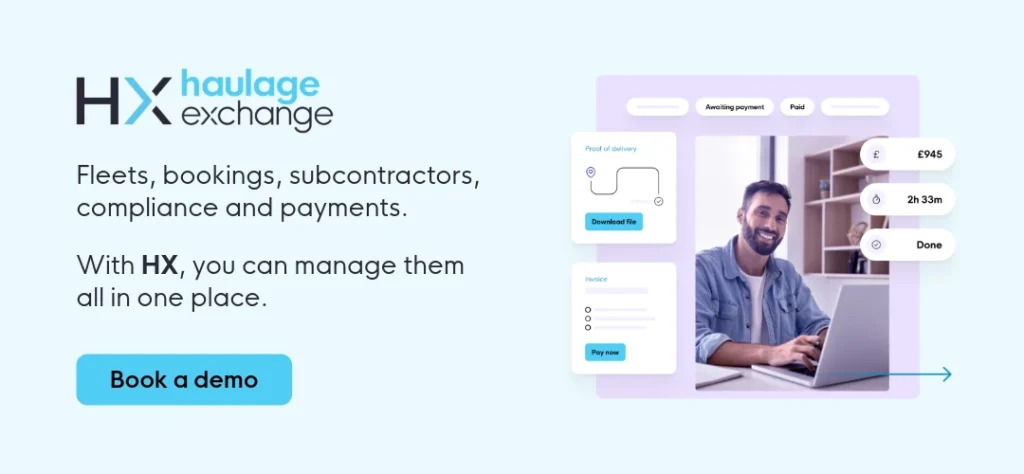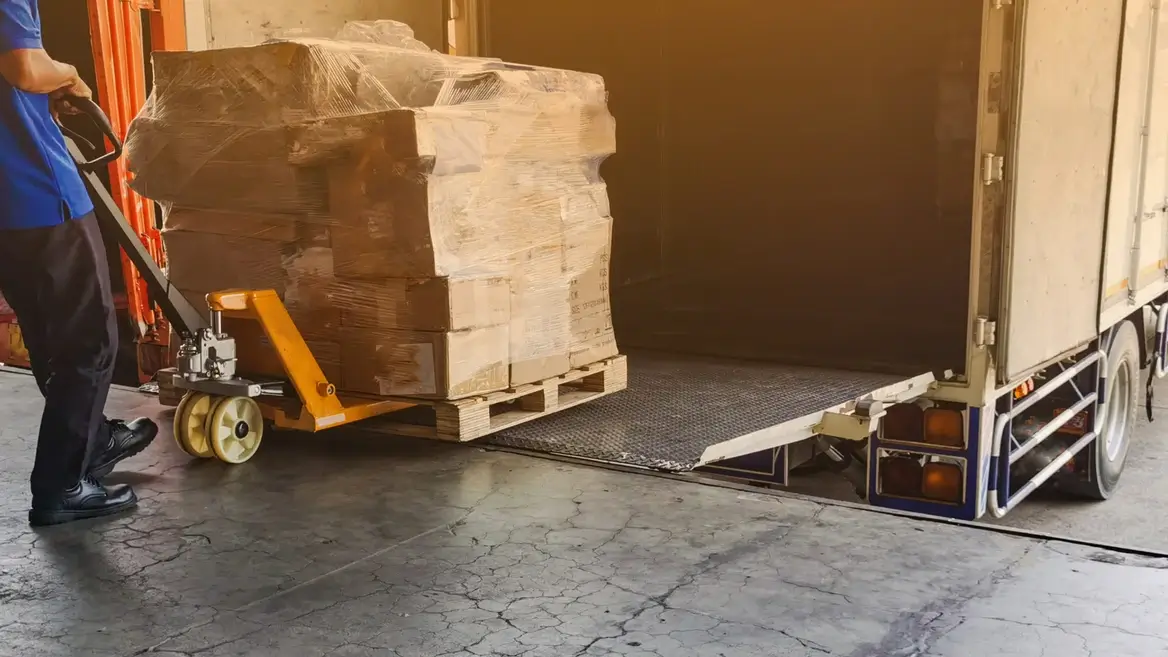As the logistics sector grows and customer expectations rise, haulage companies are increasingly looking at 3PL logistics (third-party logistics) as a new way to expand their services.
While traditional haulage mainly involves point-to-point deliveries, adding 3PL capabilities allows companies to offer a range of logistics solutions or partner directly with 3PL providers for long-term haulage contracts.
For haulage businesses, the 3PL model offers access to larger contracts, broader markets, and opportunities for building a steady stream of new clients.
In this guide, we’ll cover what 3PL logistics is, how it differs from 4PL, and how haulage companies can benefit from adopting third-party logistics services or partnering with 3PL providers.
What we’ll cover
Understanding 3PL logistics
3PL logistics involves contracting a third-party provider to handle a company’s supply chain or logistics needs.
For haulage companies, this could mean either offering additional logistics services like warehousing and order fulfilment or partnering with a 3PL provider to help handle large-scale distribution, such as moving goods between warehouses, fulfilling e-commerce orders, or handling distribution for retail chains.
How third-party logistics works
In a 3PL arrangement, a provider manages logistics on behalf of clients, often covering everything from storage and inventory to distribution and order fulfilment. Many 3PL companies use a network of hauliers, storage locations, and inventory systems to meet client needs.
Haulage companies that offer 3PL logistics might take on some of these services themselves, or they might partner with an established 3PL provider to support them with the transport aspect.
Typical 3PL services include:
- Transportation services: Managing freight movements between warehouses, retailers, and end customers. Many 3PLs connect businesses with carriers through a Freight Exchange network, reducing empty loads and improving efficiency.
- Warehousing and storage: Offering short-term and long-term storage solutions, sometimes across multiple facilities. Larger operations might even offer specialist options like a bonded warehouse for goods under customs control.
- Inventory management: Tracking stock levels in real-time, helping businesses plan ahead and avoid stockouts or overstocking.
- Order fulfilment: Picking, packing, and shipping customer orders, often integrated with ecommerce systems for faster dispatch and returns.
- Customs brokerage and freight forwarding: Handling cross-border logistics, customs paperwork, and compliance for international shipments. Companies exploring freight forwarding services often combine them with 3PL to streamline global trade.
- Returns and reverse logistics: Managing returns from customers, assessing products, and either restocking, recycling, or disposing of them properly.
How 3PL differs from traditional haulage
While traditional haulage focuses on A-to-B transport, 3PL logistics covers a broader range of logistics needs, with services extending beyond simple transport.
For haulage companies, adding 3PL services means the opportunity to work on long-term contracts, support a client’s entire supply chain, and offer integrated logistics.
Haulage companies without warehousing or fulfilment operations can still benefit by partnering with established 3PL providers to provide A-to-B haulage services.
3PL vs 4PL: understanding the differences
3PL and 4PL logistics both provide outsourced logistics services, but 4PL focuses on total supply chain management rather than only warehousing, transport, and distribution.
For haulage companies, understanding the difference helps clarify which services best align with their capabilities and goals.
What is fourth-party logistics (4PL)?
4PL logistics providers go beyond managing logistics operations—they offer strategic oversight for a company’s entire supply chain.
Acting as a single point of contact, 4PL providers manage multiple 3PL partners, oversee logistics, and look for efficiency improvements. Large companies often turn to 4PL when they need strategic control over logistics without handling the operations directly.
While most haulage companies might focus on 3PL logistics, some larger operators could expand into 4PL by offering logistics consulting and working with other logistics providers to manage client needs.
However, most hauliers see more immediate potential by starting with 3PL logistics and focusing on warehousing, distribution, and transport.
Comparing 3PL and 4PL services
The difference between 3PL and 4PL lies in their approach.
3PL focuses on operational logistics—warehousing, transport, and order fulfilment—while 4PL involves strategic supply chain management.
For haulage companies, a 3PL model offers better commercial opportunities as it allows for expansion into warehousing, client-based order fulfilment, or partnership with 3PL providers needing regular transport services.
This structure lets hauliers provide value through transport and logistics services without requiring the complex oversight seen in 4PL models.
Asset-based vs non-asset-based models
When you’re choosing a 3PL partner, understanding the difference between asset-based and non-asset-based providers is super important.
Each model offers different advantages depending on what your business needs most, whether that’s control, flexibility, or cost savings.
Asset-based carriers
Asset-based 3PLs own the trucks, warehouses, and equipment they use to move and store goods. That means they have full control over their operations and can often offer faster solutions during busy periods.
Benefits of working with asset-based providers include:
- Greater reliability, as the assets and drivers are under direct management.
- Simplified communication, with fewer third parties involved.
- Potential for better pricing on large or regular contracts.
Non-asset providers
Non-asset-based 3PLs don’t own vehicles or warehouses. Instead, they build networks of trusted partners (haulage carriers, warehouse owners, and service providers) and manage logistics using these external resources.
Advantages of working with non-asset-based 3PLs:
- Flexibility to find the best transport and storage options for every shipment.
- Wider geographic reach through their partner network.
- Adaptability during seasonal spikes or supply chain disruptions.
Because they aren’t tied to a specific fleet or warehouse, non-asset providers can be more agile and often better suited for businesses with changing needs.
Many newer logistics businesses, including those just starting a haulage company, prefer the flexibility of non-asset models while scaling up. Asset-based 3PLs, on the other hand, can sometimes be less flexible because they’ll prioritise using their own equipment.
Comparing 3PL and freight brokerage
While both 3PL providers and freight brokers move goods, their services aren’t the same.
A third party logistics company manages warehousing, inventory, fulfilment, and transport, offering an end-to-end logistics solution.
Freight brokers, on the other hand, specialise in connecting shippers with carriers without managing other logistics services.
If you only need help moving goods from A to B, a freight broker can offer flexibility without the added services. But if you need support with storage, order management, and delivery, a 3PL is the better fit.
Understanding the difference between a freight broker and a freight forwarder also helps when choosing the right partner for broader logistics needs.
Choosing between a 3PL provider and a freight broker depends on your business size, needs, and growth plans.
Businesses with complex supply chains often benefit from the full-service model of third party logistics. For smaller or one-off shipments, freight brokerage may be more cost-effective and agile.
Why haulage companies should be interested in 3PL logistics
For haulage companies, adding 3PL services or partnering with 3PL providers opens the door to new contracts, higher revenue, and access to emerging markets, such as e-commerce and retail.
Expanding services to attract new customers
By offering 3PL services, haulage companies can provide end-to-end logistics support to clients, making them a one-stop logistics solution. Businesses often prefer working with a 3PL provider to avoid the costs and logistical challenges of managing their own warehousing and transport operations.
For example, a haulage company could begin offering warehousing services through a bonded warehouse, providing secure storage for goods that are awaiting customs clearance or final delivery. This is attractive to companies that need secure, compliant storage.
Alternatively, by offering transport within the 3PL framework, haulage companies can support distribution between warehouses or fulfilment centres, bringing new work and long-term contracts with major clients.
Opportunities to enter new markets
The growth in e-commerce has driven demand for 3PL services, as more online retailers need rapid and reliable logistics support.
Haulage companies entering the 3PL market can find opportunities to support e-commerce clients by offering distribution, fulfilment, and warehousing, or by serving as the transport link in a 3PL partner’s logistics network.
Working with 3PL providers also provides flexibility to manage seasonal demand by increasing or decreasing capacity based on client needs. For instance, a haulage company working with an e-commerce-focused 3PL provider might be asked to add more vehicles to cover peak holiday seasons. This way, the company keeps its drivers busy without having to invest heavily in additional infrastructure.
Reducing operational costs
For haulage companies offering 3PL services, outsourcing storage, order management, and distribution can significantly lower costs.
For example, rather than investing in their own warehousing, companies can partner with 3PL providers who handle these facilities. By providing transport support to established 3PL providers, haulage companies avoid infrastructure expenses while still capturing long-term contracts.
By using a 3PL provider’s logistics infrastructure, haulage companies can operate more efficiently, increasing fleet use and reducing wasted journeys. Using TMS integrations also enables efficient scheduling and load management, optimising transport for fewer empty journeys and maximising profit per mile.
Improving customer satisfaction
3PL logistics helps haulage companies provide faster, more reliable deliveries, leading to better customer service. Partnering with 3PL providers that specialise in fast fulfilment, warehousing, and client support allows a haulage company to offer clients a full logistics service, improving their service quality and reputation.
For example, when partnering with a 3PL company, hauliers often receive access to advanced logistics systems that help with tracking, scheduling, and planning return haulage loads. By filling trucks on return journeys, haulage companies save costs and improve delivery speeds for clients. This capability builds loyalty and can lead to repeat contracts with satisfied customers.

Practical considerations for haulage companies
While offering 3PL logistics services or partnering with 3PL providers presents commercial opportunities, haulage companies need to carefully plan for this expansion.
Technology and software requirements
For efficient 3PL logistics, reliable technology and software are essential. Platforms like Haulage Exchange enable real-time tracking of vehicles and carrier management, load management, and streamlined communication with 3PL partners. This technology improves efficiency by allowing haulage companies to monitor routes, loads, and delivery status in real-time.
For haulage companies providing warehousing, systems that manage inventory, coordinate order fulfilment, and track shipments add value to their services.
Managing the driver workforce for expanded services
As 3PL logistics often means higher volumes and varied routes, haulage companies need to consider their driver workforce and operational management. Expanding into 3PL often requires more drivers or additional training for existing drivers to handle diverse routes, new cargo types, or faster turnarounds.
Investing in driver safety and certification programs, such as FORS accreditation, can improve safety and prepare drivers for the demands of 3PL work. Ensuring drivers are equipped to handle new requirements helps build a reliable workforce and reinforces client trust. Additionally, effective haulage driver management, like creating incentives and training on new delivery expectations, can help drivers adapt smoothly to expanded services.
Measuring performance
Measuring performance helps you stay in control and build stronger logistics partnerships. So, make sure to:
- Set clear KPIs (key performance indicators): Metrics like on-time delivery rates, inventory accuracy, and order error rates give you a simple way to track performance. Defining these expectations early helps both sides stay aligned. It also makes it easier to spot improvements or issues over time.
- Review performance regularly: Schedule check-ins to go over recent shipments, warehouse activities, and customer feedback. Regular reviews help you address problems early and keep standards high. They also show your 3PL partner that you’re invested in making the relationship work.
- Use scorecards to track broader service quality: Rate things like communication, tech support, and responsiveness to get a full picture of performance. Sometimes the smoothness of day-to-day operations matters just as much as delivery times. Scorecards also help if you ever need to renegotiate or consider switching providers.
Conclusion
3PL logistics offers haulage companies an exciting opportunity to diversify services, access new markets, and grow their client base. By offering end-to-end logistics support or partnering with 3PL providers to provide efficient A-to-B transport, haulage businesses can increase their appeal and build long-term client relationships.
As the demand for third-party logistics grows, investing in 3PL services or establishing partnerships allows haulage companies to deliver high-quality service, improve efficiency, and grow their business in a rapidly changing market.
Frequently asked questions
What does 3PL mean in logistics?
3PL stands for third-party logistics, which means outsourcing parts of your supply chain like transport, warehousing, or fulfilment to a specialist provider. It’s a way for businesses to move goods without managing all the logistics in-house.
How does a 3PL make money?
A 3PL typically makes money by charging service fees, transportation costs, storage fees, or taking a margin on freight rates. Some also offer value-added services like customs clearance or packaging to boost revenue.
What is the main difference between 3PL and 4PL?
The main difference is that 3PL companies handle the physical logistics, while 4PL providers manage and oversee the entire supply chain on your behalf. A 4PL acts more like a consultant or project manager.
Is Amazon a 3PL or 4PL?
Amazon mainly operates as a 3PL when offering fulfilment services for sellers through its network of warehouses and couriers. However, its scale and technology mean it sometimes functions like a 4PL for certain large partners.



